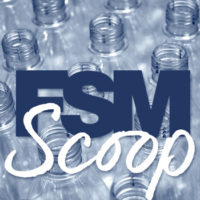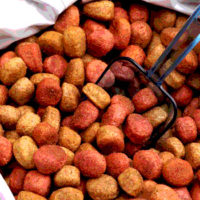FSM Scoop: Pet Food Safety

People love their pets, and it’s obvious by taking a look at what types of food pet owners are spending their hard-earned money on. The most in-demand pet foods are those that look and sound a lot like cuisine meant for humans—delicacies that are sugar-free, grain- and gluten-free, and contain reduced calories. Pet foods also offer an array of varieties to please even the pickiest of pet palates—frozen, raw, organic, all-natural, wet, dry, baked, freeze-dried, etc. Data released by GfK—Germany’s largest market research firm—revealed last summer that more Americans are spending more money on raw food for their pets. Over the course of a year, retail sales of raw, freeze-dried dog and cat food spiked a whopping 64 percent. The sale of raw, frozen pet food jumped 32 percent during the same period.
Part of the reason consumers might be willing to fork over more money for their pets is because they equate more spending to better, higher-quality products. But are pet owners pampering their pets in lieu of their own well-being?
Man’s Best Friend at Risk
Part of the reason that pet food safety is such a hot topic right now is that it’s not only animals that are at risk. According to the U.S. Food and Drug Administration’s (FDA) Pet Food Study, the trendy, raw food that pet owners are obsessing over might actually be a human hazard. That’s because raw pet food is more likely to be contaminated with Listeria or Salmonella versus traditional, non-raw pet foods. Not only are pets consuming raw foods at higher risk, but their owners are as well. The FDA believes that exposure to and handling of raw pet food makes people more susceptible to contracting foodborne illnesses—especially because not all sick pets display any noticeable signs or symptoms. This is particularly the case with dogs that contract Salmonella poisoning.[1, 2, 3]
The Great Pet Food Recall
In early 2007, the FDA was suddenly flooded with consumer complaints involving cats and dogs becoming sick after consuming certain pet foods. In just a month, the FDA logged 14,000 complaints—more than double what they were seeing in a typical year back then. At first, at least 14 animal deaths were reported in the U.S.—4 cats and 1 dog, in addition to 9 cats that died during routine taste testing conducted by the now-defunct Menu Foods—a company that sold pet foods under dozens of well-known brand names. The pets suffered from kidney failure after eating certain “cuts and gravy”-style dog and cat foods produced at Menu Foods’ facilities in Emporia, KS, between late 2006 and early 2007. Subsequent pet illnesses and deaths—1,950 cats and 2,200 dogs—are believed to have been linked to the same pet food manufacturer.[4, 5] According to Aon--a global provider of risk management solutions--Menu Foods’ recall of 60 million containers of pet food resulted in $42 million in losses attributed to the recall alone, not including lost sales.[6]
As a result of these pet illnesses, more than 150 brands of dog and cat foods were voluntarily recalled nationwide by various companies. This included all varieties—moist foods in cans and pouches, and dry foods in bags. A joint investigation with the U.S. Department of Agriculture found that contaminants in vegetable proteins imported into the U.S. from China had been used as ingredients in those pet foods. In February 2008, the FDA announced that two Chinese nationals and the businesses they operated, along with a U.S. company—ChemNutra—and its CEO would be indicted by a federal grand jury. They were accused of scheming to import products believed to be wheat gluten and rice protein concentrate into the U.S. that were contaminated with melamine—an industrial chemical approved for use in plastic and paper products—including food packaging.[7] Later testing by the FDA and Cornell University confirmed that melamine was present in the urine and kidneys of the cats that took part in the routine taste testing conducted by Menu Foods. Melamine is not FDA-approved for direct addition to human food or animal feeds marketed in the U.S.[8] The owners of ChemNutra eventually pleaded guilty to distributing adulterated food and selling misbranded food—both misdemeanors. They were sentenced to 3 years of probation. In 2011, a class action lawsuit awarded more than $12.4 million to pet owners affected by the contaminated pet food.
According to the FDA, since melamine alone is a “relatively nontoxic substance,” it is not believed to be the only culprit in the reported cat and dog illnesses and deaths. Another explanation is that cyanuric acid—also found in pet food—combined with melamine would have been more toxic than either compound alone, making it a more plausible explanation for what occurred.[9]
Altogether, it is believed that an estimated 8,000 pets died as a result of what’s since been dubbed the “Great Pet Food Recall.” But that number is not official since U.S. government agencies don’t officially track animal deaths as they do for humans.[10]
Nine Years Later
Still, 2015 was ripe with pet food recalls—particularly over the summer. In total, at least 28 pet food recalls were issued last year, according to Food Safety Magazine’s own tally. Thirty-five percent of them were due to Salmonella contamination. Others—treats for both dogs and cats—included risks of Listeria, along with low levels of thiamine (vitamin B1), high levels of vitamin D and the presence of mold or propylene glycol.
Just 2 weeks into 2015, retail giant Petco became the first national pet specialty retailer to completely remove all dog and cat treats made in China from its store shelves and website. At the time, the exact cause of the contaminated pet treats had not been determined. However, complaints of pets becoming sick from products manufactured in China had been on record with the FDA since 2007’s Great Pet Food Recall. Just as 2015 began, 5,000 reports of pet illnesses were suspected to be the result of pets consuming jerky treats—chicken, duck and sweet potato varieties—all made in China. To make up for the loss, Petco made plans to acquire safer pet snacks from countries such as Australia, New Zealand and South America.[11, 12]
In February 2015, a class-action lawsuit was filed against Purina—a Nestlé company—after claims that its popular Beneful dog food killed pets. Customers complained that after eating the dog food, their pets suffered from a variety of health problems—bladder stones, internal bleeding and liver failure. The lawsuit specifically blames the presence of mycotoxins, along with what they determined to be “antifreeze.” While dog foods are known to contain propylene glycol, antifreeze is actually ethylene glycol, which has raised some eyebrows about the validity of the lawsuit.
Money Over Pet Food Safety?
One argument in relation to the persistence of pet food recalls is that it all boils down to economics. With consumers willing to spend high prices on luxury pet food products, new companies are popping up to meet pet owners’ insatiable needs. What these companies tend to do is co-pack their pet foods with ingredients from a variety of manufacturers. Their labels display whom the product is “distributed by,” which means that one company has packaged it all together and is shipping it out. This is different from a “manufactured by” label, which means the product was packed all in one place, or at least by a single company. When co-packing is the method of choice, it can be a nightmare in terms of traceability because many companies have contributed ingredients to produce a single can or bag of pet food. To make matters worse, these inexperienced pet food companies do not always have the proper staff onboard to make sure things are running smoothly—veterinarians, pet food nutritionists, quality control specialists, etc.
In the end, these companies do not have sufficient knowledge regarding pet food safety, which results in them producing products that do not meet any federal or state standards.
Mystery Meat in Pet Food?
In March 2015, a study conducted by researchers at the University of Nottingham revealed that many pet food brands are manufactured with unspecified animal parts—parts that are not listed on food labels. Investigation into the Animal Species Contents of Popular Wet Foods analyzed 17 wet dog and cat foods sold in UK supermarkets and found that 14 of them contained chicken, cow and pig DNA. Out of seven products that were labeled “with beef,” only two of them contained more cow DNA than a combination of chicken and pig DNA. Although the absence of these ingredients might anger consumers, the omission is not against any UK laws. It does, however, introduce the possibility of consumers unknowingly feeding food allergens to their beloved pets—this according to Kin-Chow Chang, author of the study and professor of veterinary molecular medicine at University of Nottingham.[13, 14]
Then there’s the Pet Food Test—the first consumer funded, in-depth examination of pet food and its contents. Here, 12 pet food products—6 cat foods and 6 dog foods—were examined. All 12 foods were tested for bacterial content [9 contained one or more bacteria or “qualifying pathogens;” 10 contained one or more “pathogenic microorganisms;” 9 contained one or more bacteria linked to spoilage of meat; 9 contained one or more potential pathogenic bacteria), cyanuric acid (no measurable levels found), melamine (no measurable levels found), euthanizing drugs (no measurable levels found), and nutrient and mineral content (4 contained excess nutrient levels; and at least 5 instances of excess nutrient levels compared to standards set by the National Research Council and the American Association of Feed Control Officials (AAFCO)]. Due to budgetary constraints, only 8 of the 12 pet foods were tested for 37 different mycotoxins (2 were high risk, 2 were medium risk and 4 were low risk).[15]
U.S. Pet Food Regulations
Not only does the FDA have its own set of pet food regulations, but individual states have the right to enforce labeling guidelines as well, generally adopting AAFCO’s regulations and suggestions. Under AAFCO’s standards, meat deriving from cows, goats, pigs, sheep—or any combination of these animals—can simply be labeled as “meat” on pet food packaging. Meat from mammals such as horses must identify the animal source. “Poultry” is meant to signify chicken and/or duck meat.[16]
After the Great Pet Food Recall of 2007, Congress was largely forced by policy makers and animal-focused organizations to take action. Ultimately, new legislation required the FDA to enforce stricter safeguards for pet food. In September 2007, the Human and Pet Food Safety Act was unveiled, requiring the FDA to set standards for pet food, strengthen labeling rules, and establish an early warning system and post searchable online recall lists. The act also requires companies to report contaminated food and to make sure that key records are made available during investigations so that contaminants can be traced quickly.[17]
There’s also PETNet, a website developed by the FDA to help federal, state and local agencies monitor pet food safety. The system allows agencies to share pet food related incidents with each other to better determine when a recall is necessary.[18]
The FDA’s Center for Veterinary Medicine’s (CVM) is in charge of the Animal Feed Safety Program. The CVM has been tasked with “ensuring the safety of animal food, which includes feed ingredients, mixed feed, medicated feed, and pet food, treats and chews.” The system is the method by which CVM carries out all of its animal food responsibilities. In return, pet food manufacturers are responsible for producing safe products while following all applicable FDA regulations.[19]
Pet Food Safety Around the World
As far as meat and animal derivatives that go into pet food, the UK’s methods are far more advanced that what is commonly practiced in the U.S. According to the UK’s Pet Food Manufacturers’ Association (PFMA), “PFMA members use by-products of the human food industry that come from animals slaughtered under veterinary supervision. These materials meet the very high safety and quality criteria laid down by regulations. Members only use materials from species that are generally accepted in the human food chain—beef, lamb, poultry, pork, fish, rabbit and game.” The agency also enforces strict rules when it comes to the labeling of pet food products. For example, if a label displays “with chicken,” the percentage of that ingredient component must also be listed—a requirement not practiced in the U.S.[20]
Strict labeling standards are also the norm in Australia. In 2011, the Pet Food Industry Association of Australia, Inc. established the Australia Standard (AS 5812) that covers the country’s entire process of pet food production and labeling requirements. Under the standards, pet food manufacturers in Australia are required to maintain “controlled and well-documented processing,” “provide consistent and informative packaging” and they must undergo independent auditing for compliance. These standards apply not only to Australian-produced pet foods but also those imported into Australia.
Even our neighbors to the north are leery of some U.S. pet food products. Just a year ago, the Canadian Food Inspection Agency issued a federal ban on raw poultry products and live birds from six American states because of growing concern over the spread of avian flu. The ban originally included raw pet foods containing poultry products that were sourced, processed or packaged in California, Idaho, Minnesota, Missouri, Oregon or Washington. As of January 2016, the ban only applies to poultry products from Missouri and North Dakota. Also, Canadians returning from the U.S. have been prohibited from bringing these items into Canada. Canada’s overall goal was to prevent an outbreak of avian flu from crossing the U.S. border.[21]
Room for Improvement
Despite the number of pet food recalls announced in recents months and years, the FDA’s Office of Foods and Veterinary Medicine maintains that pet food safety has been steadily improving for over a decade. When commercial pet food samples were tested between 2002 and 2006, 13 percent of them contained Salmonella. But only 1.7 percent of samples collected between 2010 and 2012 contained the bacteria.[22]
Despite the number of pet food recalls in 2015, many argue that the industry has made great strides. Not only have pet food manufacturers done a better job at cleaning up their acts by upgrading their facilities and ordering more testing, but consumer expectations are keeping these companies honest. Still, pet food recalls continue to occur, likely due to time-strapped regulators and an ever-growing, global food supply chain.
Additional legislation that controls pet food safety is a continuous challenge. For example, advocacy groups want Congress to pass legislation that prohibits pet food manufacturers from using ingredients taken from 4D bins. This refers to parts of dead, dying and diseased animals that have perished not due to traditional slaughtering--chickens, cows, turkeys and others--that are then used to manufacture pet food. These are also the animal parts that have been rejected for use food produced for human consumption. In fact, according to the Decoding Pet Food report released by the Cornucopia Institute in November, flesh from dying and diseased animals loses its nutritional value. Not only that, when muscle meat is cooked at high temperatures, it forms carcinogenic heterocyclic amines and polycyclic aromatic hydrocarbons—both clearly unsafe for both pet and human consumption.[23, 24]
Making the pet food industry safer than ever is already in the works. Pet food products fall under the umbrella of the recently released Food Safety Modernization Act’s Preventive Controls rule for both human and animal food. Once fully implemented, these new requirements will establish Hazard Analyses and risk-based preventive controls for the pet food industry. Now—with varying compliance dates depending on facility size—it is up to companies to ensure that sick employees are not handling animal feed or pet food while maintaining production facilities that are clean and enforce strict handwashing rules. These same handwashing habits are also recommended for consumers who want to remain healthy pet owners.[25, 26, 27]
- http://www.fda.gov/AnimalVeterinary/ResourcesforYou/AnimalHealthLiteracy/ucm373757.htm?source=govdelivery&utm_medium=email&utm_source=govdelivery#The_Pet_Food_Study.
- http://www.cdc.gov/healthypets/pets/dogs.html.
- http://barfblog.com/2015/06/beware-the-raw-pet-food-incidence-of-salmonella-in-pets/.
- http://www.fda.gov/AnimalVeterinary/SafetyHealth/RecallsWithdrawals/ucm129932.htm.
- http://www.humanesociety.org/animals/resources/facts/menu_foods_recall.html?referrer=https://www.google.com/.
- http://www.aon.com/attachments/risk-services/2014-Emerging-Trends-Final.pdf.
- http://www.fda.gov/AnimalVeterinary/SafetyHealth/RecallsWithdrawals/ucm129575.htm.
- http://www.fda.gov/Food/ResourcesForYou/Consumers/ucm199525.htm.
- http://www.fda.gov/AnimalVeterinary/SafetyHealth/RecallsWithdrawals/ucm129932.htm.
- http://www.huffingtonpost.com/entry/pet-food-safety_55b67875e4b0a13f9d1976e7.
- https://community.petco.com/t5/Blog/Petco-Becomes-First-Pet-Specialty-Retailer-to-Remove-all-China/ba-p/53566.
- http://www.food-safety.com/news/petco-removes-china-made-dog-and-cat-treats/.
- http://www.actavetscand.com/content/57/1/7.
- http://time.com/3765180/pet-foods-animal-parts/.
- http://truthaboutpetfood.com/wp-content/uploads/2015/01/PetFoodTest1.pdf.
- http://time.com/3765180/pet-foods-animal-parts/.
- http://www.humanesociety.org/animals/resources/facts/menu_foods_recall.html?referrer=https://www.google.com/.
- http://www.humanesociety.org/animals/resources/facts/menu_foods_recall.html?referrer=https://www.google.com/.
- http://www.fda.gov/AnimalVeterinary/SafetyHealth/AnimalFeedSafetySystemAFSS/default.htm.
- http://www.pfma.org.uk/using-the-right-ingredients.
- http://inspection.gc.ca/animals/terrestrial-animals/imports/travellers/restriction-on-imports/eng/1421341696172/1421341727507.
- http://www.petproductnews.com/November-2015/How-Safe-Is-Pet-Food/.
- http://thehill.com/regulation/244915-feds-face-pressure-on-pet-food-regs.
- http://www.cornucopia.org/wp-content/uploads/2015/11/DecodingPetFoodfullreport.pdf.
- http://www.food-safety.com/enewsletter/time-for-change-from-head-to-toe-animal-food-safety-regs-are-final/.
- http://www.neogen.com/blog/fsma-and-the-pet-food-industry/.
- http://www.foodsafety.gov/keep/types/petfood/.
Looking for a reprint of this article?
From high-res PDFs to custom plaques, order your copy today!





